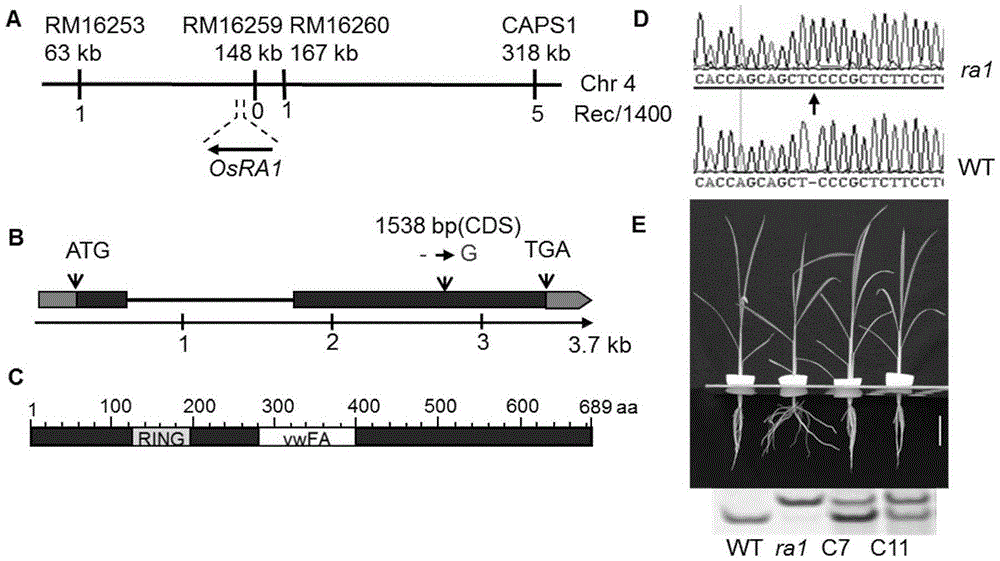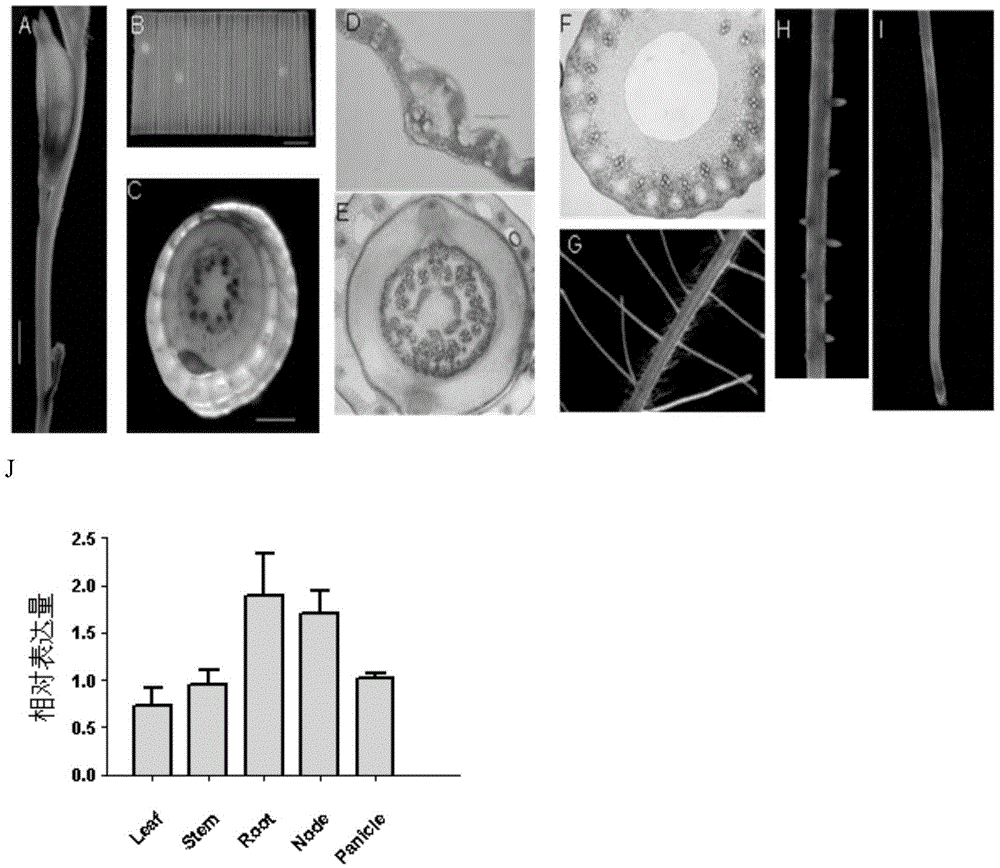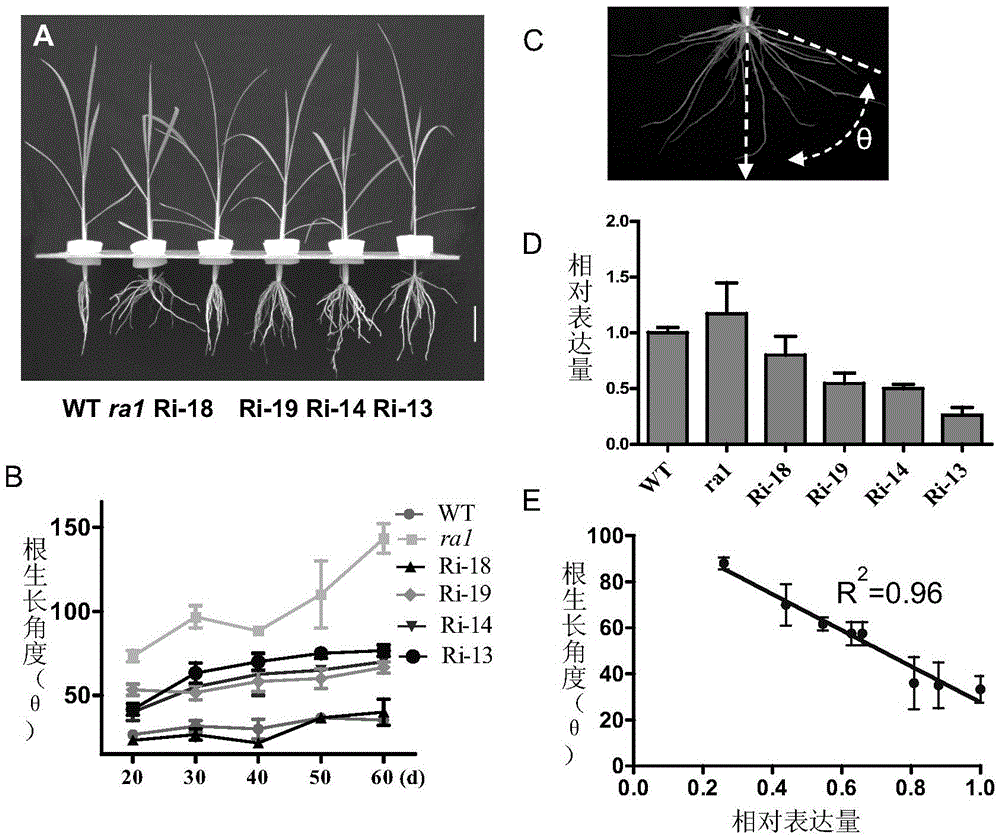Application of OsRA1 (Oryza Sativa Root Agriculture 1) in improving root configuration and nutrient efficient breeding
A root structure and nutrient technology, applied in the field of plant genetic engineering, can solve the problems of affecting the gravitational response of roots, limited application potential, and it is difficult to improve rice root structure to improve nutrient utilization, and achieve great application potential , Improve the effect of nutrient utilization
- Summary
- Abstract
- Description
- Claims
- Application Information
AI Technical Summary
Problems solved by technology
Method used
Image
Examples
Embodiment 1
[0065] Embodiment 1, OsRA1 gene cloning and identification
[0066] In the early stage, our laboratory obtained a mutant osra1 (Oryza sativa root architecture 1) with altered root system structure by screening EMS mutagenized rice M2 seeds, see (Shietal,. 2009) for details.
[0067] Rice cultivation conditions:
[0068] Cultivation temperature: 30°C during the day; 22°C at night;
[0069] Cultivation time: 12h during the day; 12h at night;
[0070] Ambient humidity: relative humidity is 65-70%;
[0071] Lighting conditions: 350molphotonsm –2 the s –1 .
[0072] Preparation of rice nutrient solution:
[0073] The rice culture solution was prepared according to the standard nutrient solution formula of the International Rice Institute (Yoshida et al., 1976), and the formula was slightly changed (the iron salt was made of Fe 3+ adjusted to Fe 2+ ). The formula is as follows:
[0074]
[0075] When in use, add 12.5 mL each of stock solution I, II, III, IV, and VI to e...
Embodiment 2
[0077] Example 2, Construction of OsRA1 promoter fusion GUS reporter vector and GUS staining
[0078] In order to study the expression pattern of OsRA1 gene in different organs, the present invention connects the OsRA1 promoter to the GUS reporter gene (OsRA1p::GUS). Using wild-type genomic DNA as a template, the OsRA1 promoter fragment was amplified with OsRA1 promoter-specific primers, and the size of the target promoter fragment was 2950bp.
[0079] Upstream primer: CACCAAATTTGACCCTCTACCTTTTC
[0080] Downstream primer: CACACACACACTCTCTCTCTCTC.
[0081] Amplification of the target promoter fragment:
[0082] Use high-fidelity enzyme (KOD-plus) for PCR amplification, the number of cycles is controlled below 28 cycles, and the reaction system is as follows:
[0083]
[0084] PCR reaction cycle parameters:
[0085] Pre-denaturation at 98°C for 3min, denaturation at 98°C for 10s, annealing at 60°C for 30s, extension at 68°C for 3min, a total of 28 cycles, and finally 5mi...
Embodiment 3
[0102] Embodiment 3, rice transgenic
[0103] Preparation of rice mature embryo callus:
[0104] 1. After husking the mature rice seeds, select the plump, smooth and spot-free seeds and put them into a beaker, and disinfect them with 70% alcohol for 2 minutes;
[0105] 2. Pour off the alcohol, add 25% (v / v) NaClO solution for disinfection for 30 minutes;
[0106] 3. Pour off the NaClO solution, wash 5 times with sterile water, and soak in sterile water for 30 minutes for the last time;
[0107] 4. Pour off the sterile water, put the seeds on sterile filter paper to blot dry, put the seeds flat in the japonica rice mature embryo induction medium, and culture them in the dark at 28°C for 10 days;
[0108] 5. Open the petri dish on the ultra-clean workbench, remove the buds and endosperm with tweezers, and leave the embryogenic callus (light yellow, dense and irregular), transfer it to the japonica rice subculture medium, and culture it in the dark at 28°C for 5- 10 days.
[...
PUM
 Login to View More
Login to View More Abstract
Description
Claims
Application Information
 Login to View More
Login to View More - R&D
- Intellectual Property
- Life Sciences
- Materials
- Tech Scout
- Unparalleled Data Quality
- Higher Quality Content
- 60% Fewer Hallucinations
Browse by: Latest US Patents, China's latest patents, Technical Efficacy Thesaurus, Application Domain, Technology Topic, Popular Technical Reports.
© 2025 PatSnap. All rights reserved.Legal|Privacy policy|Modern Slavery Act Transparency Statement|Sitemap|About US| Contact US: help@patsnap.com



